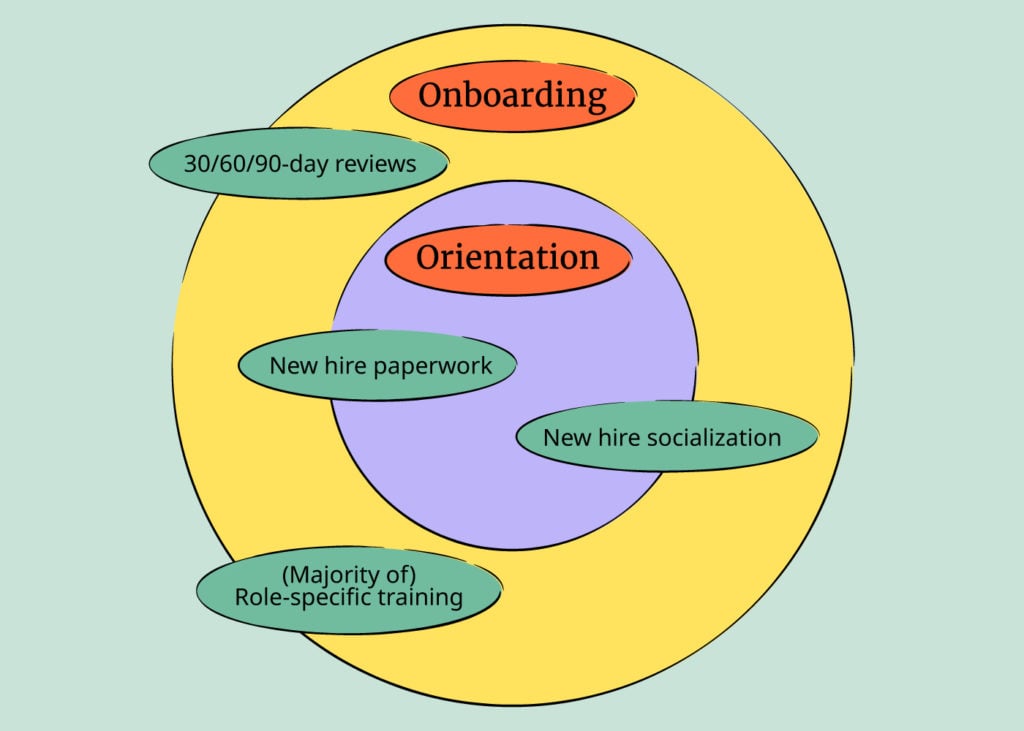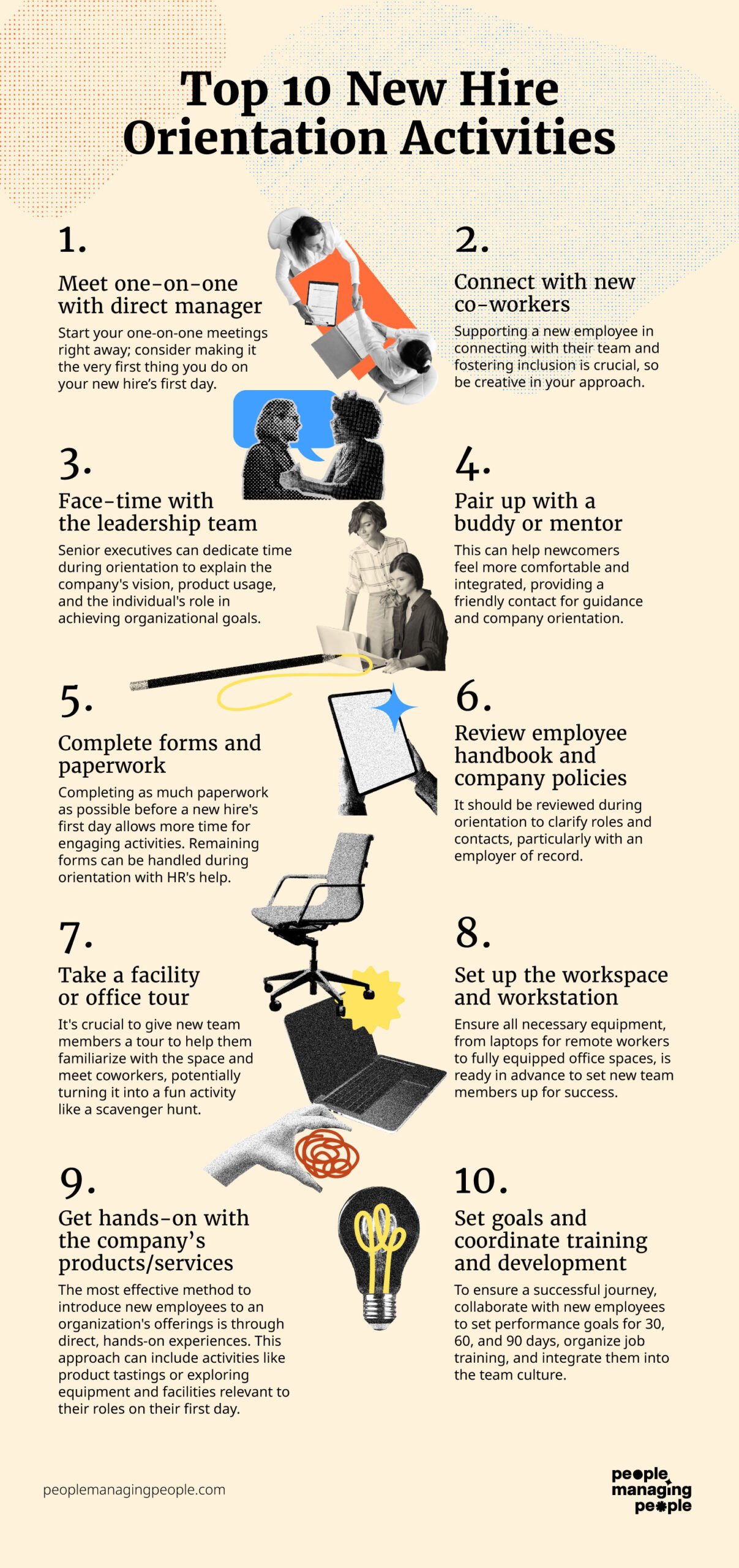A positive first impression is crucial for setting the stage for a successful tenure.
This article guides you in creating an impactful employee orientation program that will leave new hires impressed and ready to excel.
We'll run through what orientation is, why it’s important, and the top 10 activities your new employee orientation program should include with some bonus for remote workers.
Let's dive in.
What Is Employee Orientation?
Employee orientation is the process of introducing new hires to the company’s mission, culture, and structure while outlining their job role and expectations.
The process covers a review of the org’s mission and values, company policies, benefits, introductions, and tools they'll be using.
An effective employee orientation program:
- Makes new team members aware of company policies and expectations
- Helps them complete essential new hire paperwork
- Answers any questions or concerns they may have before they transition into their new position
- Provides opportunity to meet people, socialize, and start building relationships.
This contributes to a great overall onboarding experience, helps new starters get up to speed quicker, and reduces employee turnover.
Many elements can be standardized, for example a mandatory intro presentation and reading the employee handbook, however the experience will of course differ slightly from person to person.
Onboarding vs New Employee Orientation
The key difference between onboarding and new employee orientation lies in scope and duration:
- New employee orientation is a one-time event focused on introducing new hires to the company, covering basics like policies, benefits, and an overview of their role.
- Onboarding is a longer process (spanning weeks or months) designed to integrate employees into the organization fully, helping them build relationships, develop skills, and achieve long-term productivity.
In short, orientation is a part of the onboarding process, which is broader and more comprehensive.

| Orientation | Onboarding |
| 1 week | 90+ days |
| A select few activities focused on socialization | Full scope of onboarding activities |
Benefits of Good Employee Orientation
Imagine, you've gone through preboarding and it's your first day at a new job. But your first week feels unorganized and unwelcoming. Not a great first impression, is it?
A good orientation program will result in:
Increase employee engagement and satisfaction
A good orientation program can significantly boost new employee engagement and job satisfaction by making them feel valued, supported, and part of the team.
Quicker productivity
Effective orientation helps new hires understand their roles and responsibilities better, leading to a quicker and more efficient productivity ramp-up.
They will gain a clear idea of what’s expected of them, how they fit into the larger structure of the organization, who they can go to for support, and what tools they’ll be using.
Reduced turnover
A Job Seeker Nation report found that 30% of people leave during the first 90 days of starting a new job.
Orientation helps someone understand their role and feel supported, which generally means they’re less likely to leave. This reduces the costs and disruption associated with high employee turnover.
A stronger culture
As discussed, orientation programs introduce new employees to the company's culture, values, and norms.
This helps them assimilate faster and align their behavior with company expectations, fostering a more cohesive work culture overall.
Completion of compliance and safety training
Orientation is an opportunity to educate new employees about compliance issues, company policies, and safety protocols, reducing the risk of workplace incidents and legal issues.
New Hire Orientation Best Practices
Have a clear purpose
Get clear on the experience you want a new hire to have on day one and in their first week, and what the focus is (e.g., people, products, culture, etc.)
Minimize surprises
Let new hires know in advance what their first day and week will look like, everything from what the dress code is (or is not!), to what they need to bring. This helps alleviate stressors a new hire might experience before their first day.
Prepare in advance
Create a new hire checklist, schedule meetings and training sessions in advance, get their workstation ready, and prepare other team members to help.
Putting a structure in place will ensure everyone is aware of their role and nothing important is missed.
You can use our employee onboarding checklist template to help get you started.
Make it welcoming
Creating a warm and personal welcome that reflects your culture will help new hires feel valued.
Small gestures like a welcome kit or personalized desk setup can leave a lasting positive impression.
Focus on culture
Orientation is a perfect opportunity to immerse new hires in your company’s culture.
Share the organization’s mission, vision, and values, and use real stories or examples that reflect these principles in action.
This helps employees connect emotionally with the company’s purpose.
Balance information flow
Avoid overwhelming new hires with excessive information on day one. Break down content into manageable sessions and use engaging formats like videos, role-plays, or interactive discussions to keep the experience lively and impactful.
Set a reasonable pace and provide plenty of breaks and free time.
Exercise patience
Be cognizant that your new team member will almost certainly make mistakes, forget parts of their orientation program, and miss a step or two as they get up to speed.
Clarify expectations
Help new hires hit the ground running by clearly outlining their job expectations and initial goals. Walk them through key tools, workflows, and processes essential to their role, ensuring they have the clarity and resources to succeed.
Foster connection
Facilitate opportunities for new hires to build relationships within the organization. Schedule team introductions, one-on-one meetings with managers, or informal gatherings like coffee chats to help them feel integrated and supported from day one.
Leverage technology
Tools such as HRIS software, learning management systems, training software, and onboarding tools provide automated, integrated solutions to help manage the myriad of orientation tasks.
Gather feedback
Feedback is critical to improving the orientation process. Ask new hires to understand their experience and use their insights to refine and enhance your orientation program for future employees.
As well as gathering feedback in person, onboarding surveys are useful for gathering feedback about orientation and onboarding in general.
What are the Top 10 New Hire Orientation Activities?
The types of employee orientation activities will vary from organization to organization. They're largely dependent on the existing policies and processes you have in place, and how much time you’re able to dedicate to orientation.
If you work in a small business or startup where time is limited and there are few formal rules and procedures, your orientation program may just be one day of meeting new team members and getting your work environment set up.
If you’re in a more established organization, it will likely involve a larger number of orientation activities.

- Meet one-on-one with direct manager
- Connect with new co-workers
- Face-time with the leadership team
- Pair up with a buddy or mentor
- Complete required forms and paperwork
- Review employee handbook and company policies
- Facility or office tour
- Set up the workspace and workstation
- Get hands-on with the company’s products and/or services
- Set goals and coordinate training
1. Meet one-on-one with direct manager
One-on-one (1:1) meetings are a critical part of developing and fostering positive and productive relationships between you and the members of your team.
You can use your first 1:1 meeting to review the orientation program agenda, create a trust agreement, explain some team norms, and even go through their job description.
You can also use it to put your new team member at ease by addressing any concerns they might have as well as get them excited!
Pro tip: Start your one-on-one meetings right away; consider making it the very first thing you do on your new hire’s first day.
2. Connect with new co-workers
It can be tough to be the new kid on the block. There are many ways you can support your new employee in their efforts to connect with their new team members and foster their feelings of belonging and inclusion. Don’t hesitate to get creative in how you do this!
Pro Tip: New starters at Vancouver-based software provider, Thinkific, fill out a questionnaire before their first day with a couple of fun facts, such as their favorite food and proudest accomplishment. When they start, their answers are shared through the company’s Slack channel to give everyone more insight into their personality. Current team members are then able to jump onto the thread to give their own warm welcome.
3. Face-time with the leadership team
Involving a senior leader like the CEO or founder in orientation, whether it’s having the leader give an office tour or company presentation, gives that person the opportunity to help new employees understand the company culture, educate them on the company history, explain company values and expected behaviors, and take them through the company goals.
It also helps the new employee feel valued by, and connected to, leadership.
Pro tip: In my previous life as a senior executive, I would spend an hour with every new hire during orientation (this could be done virtually today) to explain our vision and mission statement, how our products were used by our customers, and how the new team member contributes to achieving our goals.
4. Pair up with a buddy or mentor
According to Greenhouse, a hiring software platform provider, “One way to help your newest employees feel more comfortable is to create a buddy system that pairs each new hire with someone who has a little more tenure at the company.”
At Greenhouse, they pair each new employee with someone in a different department. The “buddies” each take their new hire on an office tour right after their first onboarding session, and then all the buddies and their respective new hires go to lunch together on their first day.
This helps make sure new hires have a friendly face around the office and a peer to reach out to for those day-to-day types of questions.
5. Complete required forms and paperwork
Paperwork is a necessary, but often boring, part of the new hire process, so it's preferential to have your new team member complete as many of the required forms as possible before their first day.
Many HRIS systems support the digital completion of key onboarding forms, making it easy for new hires to complete them before they even start. Taking this approach allows you to focus on the more important and exciting aspects of their new job once they're ready to start.
During orientation, human resources can help your new employee check and complete any paperwork that remains to be done.
Pro tip: One idea from Jordan Boogaard at Eddy HR is to use info gathered from employees during onboarding to reward new starters when they complete their paperwork e.g. you know their favorite restaurant, give them a voucher.
6. Review employee handbook and company policies
The employee handbook is a critical tool for new hire onboarding and should be reviewed between the employee and you (or HR) as part of the orientation process.
It’s used to educate new employees on the rules and processes that govern the employment relationship, and the rights, responsibilities, and expected behaviors of the employer and the employee.
Some employees may not know what is an employer of record or what is a professional employer organization, so the handbook will have to outline the structure of the relationship and who employees should consult in different situations.
Pro tip: The employee handbook and key HR policies, such as harassment, diversity and equity, leave, and health and safety policies, should be sent in advance as part of the new hire welcome package. This allows the time during orientation to be spent addressing questions or concerns. Employee handbook software can help you to develop and maintain an effective handbook.
7. Take a facility or office tour
Depending on the size of your organization, you might have a small office space or an entire building.
Either way, it’s important to take your new team member on a tour of the work environment to familiarize them with where facilities are. It’s also a great opportunity to meet new co-workers (just remember not to overwhelm them with faces and names).
Pro tip: Don’t hesitate to get creative with your office tour. For example, consider making it into a fun scavenger hunt using a service like Strayboots or Goosechase.
8. Set up the workspace and workstation
Whether it’s as simple as a laptop delivered to a remote employee’s home for virtual work, or a dedicated office space fully equipped with furniture, computer, printer, and mobile phone, it’s important to have ready in advance everything your new team member will need to be successful.
Pro tip: Have a full list of all the required tools and equipment built into your new hire checklist to ensure that nothing gets missed (I recall one time when a manager I worked with forgot to order a laptop for their new employee, and they had to wait two weeks for one to be delivered!)
9. Get hands-on with the company’s products and/or services
There’s no better way to educate someone on what an organization delivers to its users and customers than for them to experience it for themselves.
For example, baristas at Starbucks are expected to be able to explain the differences between a wide range of beverages. On their first day of work, new employees receive coffee tastings facilitated by the store manager
Similarly, at my previous company, every new employee got to plug in and play with one of our industrial digital cameras and would get a tour of the manufacturing space.
10. Set goals and coordinate training and development
The new hire orientation program is just a part of the employee’s entire onboarding journey. To set the stage for the rest of that journey, work with your new team member to:
- Set 30, 60, and 90-day performance goals;
- Coordinate job training and skills development; and
- Continue to be integrated into the culture and team.
These activities are big pieces of work, however, and orientation can be a busy time, so don’t worry too much if you don’t get to these on your new employee’s first day or even their first week. Just make sure they get done as quickly as possible to keep the onboarding going!
BONUS: How to make remote/virtual orientation fun and engaging
Creating an engaging environment that enables relationship-building can be challenging. One thing to bear in mind is your organizational culture—doing so enables you to include relevant and appropriate items to virtual orientation.
Here are five ways to make your remote orientation more effective and engaging:
1. Send a “welcome/survival kit”
Send welcome pack to remote workers’ homes to start building a relationship with them before day one. This will help them feel like part of the organization quickly. Things you might include in your care package include:
- Company products (if relevant) like branded shirts and other merchandise
- A light ring for any videoconference calls they might have
- A company-branded, vacuum-insulated bottle (e.g., a Thermos)
- A personal note from the CEO/Department head welcoming them to the organization
2. Send an electronic gift card
Buy your remote new hire breakfast/lunch during orientation and share lunch with all new hires to better get to know each other.
Of course, be mindful of dietary restrictions and preferences. To avoid any shocks, a neat trick is to send them a questionnaire before orientation day, subtly ask them about their favorite food/restaurant, and send them a voucher.
3. Ensure orientation includes guest speakers
Include some guest speakers from their own team/department and from other parts of the organization they’ll depend on:
- Part of orientation might involve having each new hire’s respective manager join virtual orientation and enter a breakout room for a defined amount of time (e.g., 30 minutes). This will support new hires in getting to know their new managers on day one
- Have members of the HR team jump on to chat through information relevant to their roles (i.e., Benefits team member talking about benefits)
- Have senior leaders alternate a conversation around organizational culture, or otherwise record and play a video that includes senior leaders talking about company mission, values, etc.
- Build in virtual coffee chats with senior leaders throughout orientation. A senior leader can host a virtual game or fun conversation in between paperwork and policy overviews to keep folks engaged
4. Share a digital new hire library
Include standard operating procedures, helpful hints, tips, and guides for new employees to get their bearings more quickly.
This can include Company glossary with terms, abbreviations, etc. and useful training and videos about the company and its culture
5. Conduct a virtual scavenger hunt
Later on during orientation, you can use a virtual scavenger hunt to help reinforce key information.
Things to include might be items related to company culture and history, components involving the identification of members of the senior leadership team, and information about or examples of products and services the company offers
Spice it up by making your scavenger hunt themed around an upcoming holiday, event, or movie while reinforcing important information about the company and team.
Employee Orientation Checklist
Before the first day
- Preparation
- Set up workspace, tools, and equipment (computer, phone, email, software access).
- Create a schedule for the orientation process.
- Notify the team of the new hire’s start date.
- Send a welcome email with first-day details (arrival time, dress code, contact person).
- Documentation
- Prepare employment paperwork (contracts, tax forms, direct deposit forms).
- Organize benefits enrollment materials.
First day
- Welcome and introduction
- Greet the new hire warmly upon arrival.
- Introduce them to their manager and team members.
- Provide a welcome kit (e.g., company swag, handbook, contact list).
- Orientation overview
- Share the agenda for the day/week.
- Explain the purpose of the orientation process.
- Company overview
- Present company history, mission, vision, and values.
- Highlight organizational structure and key leadership.
- Policies and procedures
- Review employee handbook.
- Discuss workplace policies (attendance, dress code, remote work).
- Workplace tour
- Show around the office or virtual workspace tools.
- Highlight key areas (break rooms, restrooms, emergency exits).
First week
- Job role and expectations
- Explain the new hire’s role, responsibilities, and goals.
- Provide an overview of tools, workflows, and key tasks.
- Benefits and compensation
- Review benefits, perks, and payroll processes.
- Assist with benefits enrollment if needed.
- Training and resources
- Introduce required training programs and materials.
- Assign initial tasks or projects to start learning hands-on.
- Connection vuilding
- Arrange meetings with team members, managers, and key stakeholders.
- Schedule informal gatherings or team-building activities.
Sample Template For A New Hire Orientation Agenda
Now you should have a good idea of what employee orientation is, why it’s important, and what activities are typically included in an orientation program. But you may well be asking, “How do I put it all together, and which activities should come first, second, etc.??”
To help you with that we’ve provided a sample agenda for a two-day orientation program, which you can download below. You can use this as a sort of new employee orientation checklist to make sure things aren’t missed.

Get our employee orientation template!
To Employee Orientation And Beyond
Employee orientation is an important step in your onboarding workflow, one of those ‘moments of truth’ to borrow a term from the employee experience world.
Getting it right will ultimately contribute to improved productivity, engagement, employee retention rates, and provide a better onboarding ROI.
Key takeaways
- Start employee orientation even before a new starter’s first day to maximize impact
- Ensure new starters have plenty of face-time with their manager and colleagues
- Pairing with a buddy or mentor will lead to faster learning and higher engagement.
Zooming out, it's important new employees are supported as much as possible during the first few months in their new role.
This includes regular check-ins with their manager and you might also consider activities such as pairing or mentorship.
It's considered best practice to create a 30, 60, 90 day-plan that includes standard elements but is customizable for each role and individual.
Beyond that, you'll want to look at how to measure onboarding success so you can fine tune your process and keep improving.
Subscribe To The People Managing People Newsletter
For more advice on employee orientation and onboarding in general, subscribe to out weekly newsletter for HR and business leaders. You'll receive all our latest content to help you grow in your career and make greater impact in your org.



